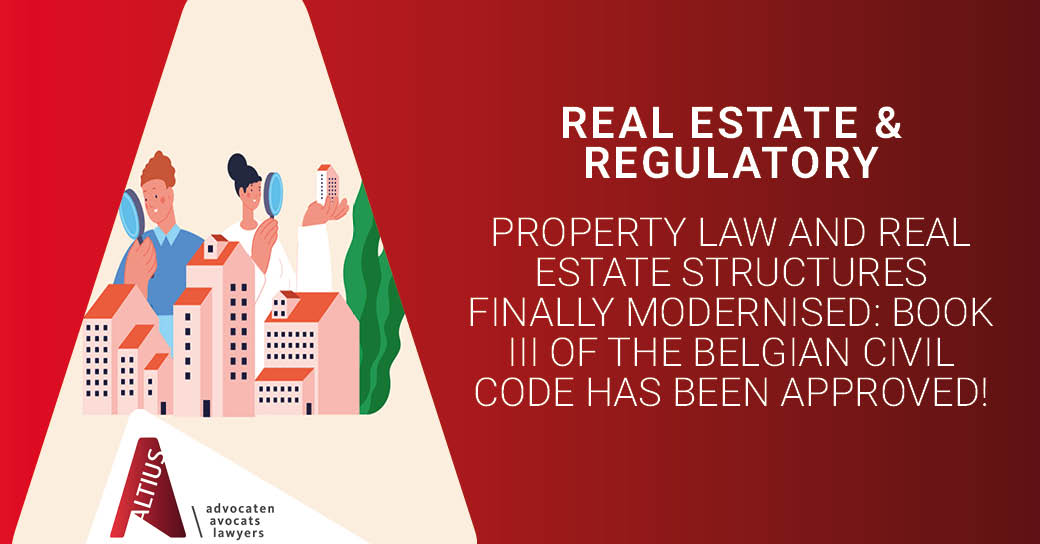Property law and real estate structures finally modernised: Book III of the Belgian Civil Code has been approved!

On 30 January 2020, the new Book III on Goods was approved by the Belgian parliament (hereafter “Book III”). The new updated Belgian Civil Code will consist of nine books (Book VIII “Rules of Proof” will enter into force on 1 November 2020 and Book V “Obligations” is currently pending before the Belgian Parliament). Book III will fully apply from the first day of the 18th month after its publication in the Belgian State Gazette.
What are Book III’s characteristics? What are its most important developments? How will it affect future (and current) real estate structures? In a series of blogs, I will look into the detail of this new Book III with a particular assessment of the practical impact for real estate projects.
According to the parliamentary documents, the aim is to modernise the law on goods by structurally inserting it into the Belgian Civil Code in order: to ensure transparency and legal security, to make it more practical and in line with the needs of our current society, and to make it more flexible by finding a balance between contractual liberty and legal certainty. Book III surely is a modernisation, but does not entail a revolution either.
The legislator has looked for inspiration and lessons learned mainly from the Dutch Civil Code, the Civil Code of Québec and the French Avant-projet du droit des biens. The Civil Codes of Germany, Switzerland and Spain have, to a lesser extent, been a source of inspiration.
BOOK III is an integrated and mainly supplemental approach towards goods and property law
Until now the main elements of property law where to be found in the Belgian Civil Code (with its essence dating back to the Napoleonic Code of 1804) and some specific laws of 1824 on the right to build (“opstal/superficie”) and on the long-term lease (“erfpacht/emphytéose”). After some 200 years, this legislation needed some brushing-up to meet or at least approach modern requirements.
Book III deals with the following chapters (i) general introductory clauses on goods, (ii) division of goods (movable versus immovable), (iii) property law, (iv) co-ownership (which largely remains unchanged as it has already been recently modernised), (v) neighbours’ relations (including easements), (vi) usufruct, (vii) long-term leases and (viii) the right to build.
To increase the level of integration within the Belgian Civil Code, large parts of the Field Code, the 1824 laws on the right to build and long-term leases, and the laws on found and abandoned goods, will be abolished as a result of Book III’s entry into force.
Book III starts with the principle that the parties can deviate from its clauses, except for its definitions or if the law determines otherwise. So while Book III mainly has a supplemental nature, it will be the starting point for parties when they negotiate a real estate (investment) structure. The obligatory character of definitions is important to note. In the past, the choice between a right to build and a long-term lease was often not determined by the core elements of their legal definition but was rather based purely on the length of the relevant real right. The legislator has now made these two rights almost interchangeable for duration and has focused instead on their core elements to make a distinction.
As before, only the legislator can create real rights (“droits reels/zakelijke rechten”), which strictly limits the number of real rights to property law, co-ownership, real use rights (“droits réels d’usage/zakelijke gebruiksrechten”) and real securities (“sûretés réelles/zakelijke zekerheden”).
The real use rights are easements, usufruct, long-term leases and the right to build. The real securities consist of the special privileges, pledges, mortgages and retention rights.
When will Book III enter into force ?
Book III will enter into force on the 1st day of the 18th month after the month of its publication in the Belgian State Gazette. So it seems at first that we are looking already far into 2021 but…
Unless the parties decide otherwise, Book III will not apply to (i) the future consequences of legal acts or facts originating before the date of entry into force or (ii) legal acts or facts originating after the date of entry into force regarding real rights originating before it. Book III cannot cause prejudice to rights acquired before its entry into force.
From the above rule you can deduct two important practical consequences:
- the parties can decide to apply Book III as from an earlier date to their new real estate structures; and, on the other hand,
- the current legal rules will continue to apply for a long term (e.g. for a recent long-term lease of 99 years).
Book III also provides for a specific regime for rights to build entered into before the entry into force of Book III to the extent that they relate to the creation of a division in volumes (see below for more on volumes). In such a case, the fixed term of the right to build can already be more than 50 years or the duration will be considered “eternal” if not determined or vested for an indefinite period of time.
So in practice there might be a vast period of overlap between the current legal regime and Book III.
Main developments for the various real rights
It is important for existing and future real estate investments and structures that the changes and developments introduced for the real rights such as usufruct, the right to build and/or the long-term lease right.
Here in a nutshell are the developments:
3.1. Usufruct
Usufruct will still be linked to the “life” of the party concerned and it will end with the “end of that life”. Book III now clearly stipulates that usufruct ends in the event of bankruptcy or voluntary, legal or judicial dissolution, but not in the event of merger, splitting or similar operations. This puts an end to the (doctrinal) discussion in that respect.
In Book III, a right of usufruct can be vested to the benefit of legal entities for a period up to 99 years (whereas now the maximum term is 30 years). The same is valid for physical persons unless the person on whose life the usufruct is vested is still alive at that time. The recent increase in the number of centenarians has had its influence here.
The owner’s repair obligation is still linked to the structural elements of the real estate, but the latter can request from the usufruct beneficiary a contribution in the costs of such repair works regarding the value of the right of usufruct compared to the right of ownership, i.e. at the beginning of the usufruct right, the share in the costs for the beneficiary of the usufruct will be higher.
3.2 Long-term lease
Whereas today a long-term lease must be for a minimum of 27 years and a maximum of 99 years, Book III reduces the minimum term to 15 years. The Belgian legislator was inspired here by the examined international civil codes to reduce the minimum term to make it more usable in practice, e.g. real estate leasing required contracts of 15 years to align civil law rules with VAT-rules.
Also the imposed annual payment of a cannon to honour the right of ownership has disappeared in Book III and thus there will come to an end the many symbolic annual payments of €1. This annual payment is considered no longer an essential part of the long-term lease.
Book III also provides that at the end of the long-term lease the owner is to indemnify the long-term lessee for the constructions and plantings made by the latter within the boundaries of its right, mainly inspired by such a principle in the Dutch Civil Code (but the exceptions to the principle set out in the Dutch legislation have not been adopted).
3.3 Right to build
In Book III, a right to build can now have a term of 99 years (instead of a maximum of 50 years) and is as such aligned with a long-term lease.
In some exceptional cases a right to build can be “eternal” if the following conditions are met: the right to build is vested by the owner of the land for (i) the purposes of public domain, or (ii) the creation of volumes that each have a different destination and between them do not share any common parts.
The difference between a right to build and a long-term lease is that a right to build includes an ownership right on a volume in order to acquire or build constructions or plantings as a result of a split of ownership of real estate. Whereas a long-term lease is more focused on the enjoyment and use without including an ownership right, which as such remains with the bare owner.
3.4 The birth of “volumes” under Belgian law
Book III does provide for the creation of volumes in the event of a complex and heterogeneous real estate with at least two volumes that (i) have different destinations, (ii) can be managed independently and (iii) do not share any common parts as otherwise the rules of co-ownership will still apply. One can think of a shopping centre or public area with an underground parking (normal multi-residential buildings will still have common parts and will thus not enjoy the benefit of the simplicity of a volume structure). The Belgian legislator was inspired by neighbouring countries to create the ownership of volumes.
The lack of effective realisation of a volume in such a structure can trigger the 30-year statute of limitations as a result of which the “eternal” character of the structure of volumes is lost.
Bringing it all together:
Book III is certainly a modernisation of the law on goods and property law that is centralised within the Belgian Civil Code based upon a comparison with other jurisdictions, which ensures the benefit of lessons learned from those neighbouring jurisdictions.
It is clear that in the future real estate structures will be different as essential elements in the definitions of the real rights have been redefined and the equilibrium of rights and obligations of the various real rights has shifted.
Given the supplemental nature of Book III, careful drafting of contracts will determine which party benefits the most out of (deviating from) Book III.
In the following blogs I will discuss in further detail the various real rights in Book III.
Written by
Recommended articles
Belgium aims for hospitals to increase their biosimilars uptake
Despite many initiatives by the (former) Minister of Health, the uptake of biosimilars in Belgium has remained rather low. In this blog, we summarise the new rules, which apply since 2 October 2023.
Read onBelgian Supreme Court rules on the consequences for commercial lease agreements of the lock-downs during the COVID-19 pandemic
The Supreme Court (“Hof van Cassatie/Court of Cassation”) overruled on 26 May 2023 a decision that determined that Article 1722 (old) Civil Code (a partial or total “destruction” of the leased premises) does not apply for the tenant that can not operate its premises due to the measures taken by the Belgian Government in order to prevent the spread of the COVID-19 pandemic.
Read onHow to challenge an award decision in Belgium
Public procurement is all about tendering. And tendering is about winning and… losing. Often, in-house lawyers need urgent advice on how to challenge award decisions. Here are some tips and tricks.
Read on


